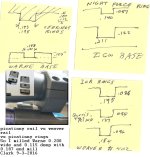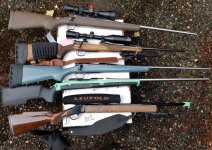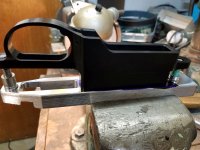With less than 1.0 to 1.5 times the minor diameter [root] of the threads engaging the failure with too much torque will be the female threads stripping out. With more than 1.0 to 1.5 times the minor diameter of engagement, the screw will snap off. What causes the screw to snap off is mostly tension and very little torque stress. The amount of torque to snap a screw dry, must be derated to 75% with oil or grease and 50% with wax. Less friction means more tension with the same torque, and it is tension, remember, that causes the snap off. There is very little change tension in scope base screws in recoil. It is all in the pre load, operator error. Name brand US made screws are much stronger than Chinese no name.
Scope base screws are not stressed in shear, but in tension.
If my 142 gr bullet maximum acceleration is from 500 fps to 2000 fps in 0.4 ms then an 8 pound rifle will try to accelerate from 1.27 fps to 5.07 fps in 0.4 ms. This is an acceleration of 9500 ft/sec squared.
If a 2 pound scope were part of that 8 pound rifle during that acceleration the force between the rifle and the scope would be
f = m a = 2 pounds 9500 f/ss = [9500 f/ss] [2 pounds / [Gc = 32 f/ss]]= 594 pounds.
If there were 4 screws in shear that would be 148 pounds force / screw.
That screw has a 0.12" minor diameter
A = pi r r = .011 sq in
Grade 5 bolt [American cap screws] has a shear strength of 72,000 psi
Each screw would have a shear strength of 814 pounds.
But they are not in shear.
They are in tension.
Grade 5 bolts are good for 127,000 psi in tension.
Each screw is good for 1436 pounds force in tension.
They are pre loaded to about half that, making a clamping force of 700 pounds.
The coefficient of static friction between the steel scope base and the receiver is ~ 0.6
So each screw provides a static state up to 420 pounds recoil force.
4 screws 1680 pounds.
But the hard kicking lightweight rifle and heavy scope only have 594 pounds peak force between them.
1680 pounds friction is greater than 420 pounds recoil, therefor the bases stay put.
If they were to slip, the screws might see shear forces, but that would require operator error in tightening the screws.
The minor diameter of #4 screws is 0.085", so they would work too.
I am just making this stuff up, so you stop me if you find any errors.
You Google this and you tell me if anyone else on the internet has figured this out.
I think I learned something. I have long been puzzled. With my hundreds of beater rifles and those I help at the range, half the time the problem with poor groups is loose base screws. Never the ring caps or cross bolts. Why do just the base screws get loose?
https://en.wikipedia.org/wiki/Friction
Scroll down to steel on steel coefficient of static friction.
Clean and dry: 0.76 - 0.80
Lubricated: 0.16
Who would put oil on a gun?
That could cause a scope mounting failure in recoil.



